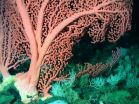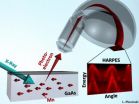(Press-News.org) The ability of deep-sea corals to harbor a broad array of marine life, including commercially important fish species, make these habitat-forming organisms of immediate interest to conservationists, managers, and scientists. Understanding and protecting corals requires knowledge of the historical processes that have shaped their biodiversity and biogeography.
While little is known about these processes, new research described in the journal Molecular Ecology helps elucidate the historical patterns of deep-sea coral migration and gene flow, coincident with oceanic circulation patterns and events. The investigators propose a scenario that could explain the observed evolutionary and present-day patterns in certain coral species. The findings can help scientists determine how climate change and other global processes have affected ocean habitats in the past and how they might do so in the future.
"The information generated in this study provides critical baseline data with which the potential effects of disturbances, such as global warming and ocean acidification, on populations inhabiting earth's largest biome can be assessed," says first author Santiago Herrera, a PhD candidate at the Massachusetts Institute of Technology and the Woods Hole Oceanographic Institution (WHOI). The research will also provide new opportunities to examine ancient migration patterns of other marine organisms.
Herrera and his colleagues have been investigating ancient deep-water coral migration patterns from various seamounts—geological features that rise at 1,000 meters or more from the seafloor and often form long chains—and other hard-bottom habitats such as canyons, fjords, and continental slopes. The investigators' analyses involve the utilization of museum specimens, some of which date back to the mid 19th century.
This latest study focused on one species of coral: Paragorgia arborea, also known as bubblegum coral. This coral has been found at polar, subpolar, and subtropical regions of all of the world's oceans. Few studies have evaluated the overall genetic diversity of widespread deep-sea species, and researchers have wondered whether Paragorgia arborea is in fact a single species on a global scale or whether it has evolved into a set of 'cryptic' species, in which they exist as a set of genetically distinct species that are morphologically indistinguishable.
"Analysis of eight gene regions from more than 100 individual corals, collected worldwide over the last 134 years, revealed evidence that individuals collected in regions separated by tens of thousands of kilometers at depths ranging from 100 to 1,500 meters belong to the same species," says co-author Timothy Shank, an associate scientist at WHOI and Herrera's mentor. "This genomic and sampling coverage represents an unprecedented effort towards solving fundamental evolutionary questions in deep-water corals," he adds.
The team also found significant differences in the genetic composition of the populations of this species, indicating that individuals from each population are much more likely to reproduce locally with neighboring individuals, rather than with individuals from other populations elsewhere. "These differences can be explained by the spatial separation of different ocean basins; however, depth does not seem to be an important structuring factor," says Herrera. "We identified five main populations: North Atlantic, Southern Indian, South Pacific, Western North Pacific, and Eastern North Pacific."
Surprisingly, the researchers found that populations of Paragorgia arborea from the North Atlantic share a more recent historical connection with the southern hemisphere populations, rather than with the North Pacific populations, which are much closer geographically. This connection seems to have occurred during the late Miocene - early Pliocene period. Other researchers studying different marine organisms such as spiny dogfishes and bryozoans, also known as moss animals, have found this same historical genetic diversity pattern. Furthermore, the findings are consistent with the latest ocean circulation models for the epoch.
These results from the deep sea stand in marked contrast with the hypothesis of a trans-Arctic interchange, which suggests a recent migratory connection between the North Pacific and North Atlantic based on the distribution of several shallow-water organisms such as red algae, sea stars, bivalves, gastropods, barnacles, and seagrass.
"There were many bubblegum coral specimens available from northern locations and very few from southern latitudes to test our hypotheses. So, nine years ago we started to search for specimens in the southern hemisphere, and thanks to our collaborators in New Zealand (NIWA) and Australia (CSIRO), we were able to gather a numerous collection of Paragorgia specimens from the south that allowed us to perform a robust global analysis," says senior author Juan Sanchez, director of the marine molecular biology laboratory of the Universidad de los Andes, in Colombia.
Moving forward, the scientists plan to expand their research. "The next steps from this study will be to test what small-scale environmental factors produce the differences we see in the genetic composition of neighboring populations—such as the Western and Eastern North Pacific populations—and to try to identify specific adaptations of populations of this species that live at the environmental extremes of its distribution, for example at very shallow and deep depths, and in conditions of relatively low and high pH," says Herrera.
They also plan to study whether the historical connectivity patterns seen in Paragorgia arborea are found in other deep-sea species, which will give them a better understanding of the origin of the biological diversity present deep within the oceans.
"The observed genetic diversity patterns, and the inferred evolutionary history of origin and spread of Paragorgia arborea could explain the current distribution patterns of many other marine taxa, for example deep-sea coral symbionts, such as brittle stars and squat lobsters, and thus might have played an important role shaping existing deep-sea faunal diversity. " says Herrera.
INFORMATION:
This research was based on work supported by the Global Census of Marine Life on Seamounts Project (CenSeam), the Facultad de Ciencias - Department of Biological Sciences of the Universidad de los Andes, the National Systematics Laboratory of NOAA's National Marine Fisheries Service, the Smithsonian Institution, the Systematics Association, the Linnean Society of London, and the Sigma Xi Research Society.
The Woods Hole Oceanographic Institution is a private, non-profit organization on Cape Cod, Mass., dedicated to marine research, engineering, and higher education. Established in 1930 on a recommendation from the National Academy of Sciences, its primary mission is to understand the oceans and their interaction with the Earth as a whole, and to communicate a basic understanding of the oceans' role in the changing global environment.
Genetic patterns of deep-sea coral provide insights into evolution of marine life
Patterns also shed light on how environmental disturbances affect aquatic organisms
2012-10-24
ELSE PRESS RELEASES FROM THIS DATE:
New finding could pave way to faster, smaller electronics
2012-10-24
University of California, Davis, researchers for the first time have looked inside gallium manganese arsenide, a type of material known as a "dilute magnetic semiconductor" that could open up an entirely new class of faster, smaller devices based on an emerging field known as "spintronics."
Materials of this type might be used to read and write digital information not by using the electron's charge, as is the case with today's electronic devices, but by using its "spin."
Understanding the magnetic behavior of atoms is key to designing spintronics materials that could ...
New paper examines shifting gears in the circadian clock of the heart
2012-10-24
A new study conducted by a team of scientists led by Giles Duffield, assistant professor of biological sciences and a member of the Eck Institute for Global Health at the University of Notre Dame focuses on the circadian clock of the heart, and used cultured heart tissue. The results of the new study have implications for cardiovascular health, including daily changes in responses to stress and the effect of long-term rotational shift work.
Previous studies by a research group at the University of Geneva demonstrated a role for glucocorticoids in shifting the biological ...
Droplet response to electric voltage in solids exposed
2012-10-24
DURHAM, N.C. – For the first time, scientists have observed how droplets within solids deform and burst under high electric voltages.
This is important, the Duke University engineers who made the observations said, because it explains a major reason why such materials as insulation for electrical power lines eventually fail and cause blackouts. This observation not only helps scientists develop better insulation materials, but could also lead to such positive developments as "tunable" lenses for eyes.
As the voltage increases, water droplets, or air bubbles, within ...
Analysis of dinosaur bone cells confirms ancient protein preservation
2012-10-24
A team of researchers from North Carolina State University and the Palo Alto Research Center (PARC) has found more evidence for the preservation of ancient dinosaur proteins, including reactivity to antibodies that target specific proteins normally found in bone cells of vertebrates. These results further rule out sample contamination, and help solidify the case for preservation of cells – and possibly DNA – in ancient remains.
Dr. Mary Schweitzer, professor of marine, earth and atmospheric sciences with a joint appointment at the North Carolina Museum of Natural Sciences, ...
NJIT math professor calls Detroit Tigers a favorite to win World Series
2012-10-24
Since the Major League Baseball Division Series and League Championship Series have determined which teams will compete in the World Series, NJIT Math Professor Bruce Bukiet has again analyzed the probability of each team taking the title.
"The Detroit Tigers have a solid advantage over the San Francisco Giants. The Tigers, who surprisingly swept the New York Yankees in four straight games in the American League Championship Series to reach the World Series, have a 58 percent chance of beating the Giants in the best of seven series," he said.
At the season's start, ...
Medical recommendations should go beyond race, scholar says
2012-10-24
EAST LANSING, Mich. — Medical organizations that make race-based recommendations are misleading some patients about health risks while reinforcing harmful notions about race, argues a Michigan State University professor in a new paper published in the journal Preventive Medicine.
While some racial groups are on average more prone to certain diseases than the general population, they contain "islands" of lower risk that medical professionals should acknowledge, said Sean Valles, assistant professor in MSU's Lyman Briggs College and the Department of Philosophy.
For instance, ...
New Jersey's teen driver decals linked with fewer crashes
2012-10-24
A new study from The Children's Hospital of Philadelphia (CHOP) provides initial evidence that New Jersey's Graduated Driver Licensing (GDL) decal requirement lowers crash rates among intermediate (i.e., probationary) teen drivers and supports the ability of police to enforce GDL provisions. The study, which linked New Jersey's licensing and crash record databases to measure effects of the requirement, was published today in the American Journal of Preventive Medicine. Crash involvement of an estimated 1,624 intermediate drivers was prevented in the first year after the ...
Leaner Navy looking at future technology, fleet size and sequestration
2012-10-24
ARLINGTON, Va.—Adm. Mark Ferguson, vice chief of naval operations, headlined the opening of the ONR (Office of Naval Research) Naval S&T (science and technology) Partnership Conference and ASNE Expo Oct. 22, 2012, and highlighted the importance of innovative S&T programs being developed by the Navy. He also offered a revealing look at the potential future for the Navy if sequestration, or automatic defense cuts, goes into effect in January.
Speaking to a capacity crowd as keynote speaker, Ferguson said the Navy is already working hard to do more across the globe—with ...
Local wildlife is important in human diets
2012-10-24
Animals like antelope, frogs and rodents may be tricky to catch, but they provide protein in places where traditional livestock are scarce. According to the authors of a new paper in Animal Frontiers, meat from wild animals is increasingly important in central Africa.
"The elephant or hippopotamus may provide food for an entire community, smaller antelope may feed a family, while a rat or lizard may quell the hunger of an individual. Alternatively, these species are often sold on the road side or at local markets to supply a much needed source of cash revenue," write ...
Helping North America's marine protected areas adapt to a changing climate
2012-10-24
This press release is available in French and Spanish.Tampa, Florida, 23 October 2012—Top marine predators like tuna and sharks are suffering from the effects of climate change as the availability of prey decreases and the spatial distribution of their prey shifts. Countless other marine plants and animals are also affected.
One way to adapt to or mitigate these changes is to design marine protected areas (MPA) and MPA networks that integrate these and other climate-related considerations. Accordingly, the Commission for Environmental Cooperation (CEC) has published Scientific ...
LAST 30 PRESS RELEASES:
Manta rays create mobile ecosystems, study finds
Study: Mixed results in using lipoic acid to treat progressive multiple sclerosis
Norbert Holtkamp appointed director of Fermi National Accelerator Laboratory
New agentic AI platform accelerates advanced optics design
Biologists discover neurons use physical signals — not electricity — to stabilize communication
Researchers discover that a hormone can access the brain by hitchhiking
University of Oklahoma researcher awarded funding to pursue AI-powered material design
Exploring how the visual system recovers following injury
Support for parents with infants at pediatric check-ups leads to better reading and math skills in elementary school
Kids’ behavioral health is a growing share of family health costs
Day & night: Cancer disrupts the brain’s natural rhythm
COVID-19 vaccination significantly reduces risk to pregnant women and baby
The role of vaccination in maternal and perinatal outcomes associated with COVID-19 in pregnancy
Mayo Clinic smartwatch system helps parents shorten and defuse children's severe tantrums early
Behavioral health spending spikes to 40% of all children’s health expenditures, nearly doubling in a decade
Digital cognitive behavioral treatment for generalized anxiety disorder
Expenditures for pediatric behavioral health care over time and estimated family financial burden
Air conditioning in nursing homes and mortality during extreme heat
The Alps to lose a record number of glaciers in the next decade
What makes a good proton conductor?
New science reporting guide published for journalists in Bulgaria
New international study reveals major survival gaps among children with cancer
New science reporting guide published for journalists in Turkey
Scientists develop a smarter mRNA therapy that knows which cells to target
Neuroanatomy-informed brain–machine hybrid intelligence for robust acoustic target detection
Eight SwRI hydrogen projects funded by ENERGYWERX
The Lundquist Institute and its start-up company Vitalex Biosciences Announces Strategic Advancement of Second-Generation fungal Vaccine VXV-01 through Phase 1 Trials under $40 Million Competitive Con
Fine particles in pollution are associated with early signs of autoimmune disease
Review article | Towards a Global Ground-Based Earth Observatory (GGBEO): Leveraging existing systems and networks
Penn and UMich create world’s smallest programmable, autonomous robots
[Press-News.org] Genetic patterns of deep-sea coral provide insights into evolution of marine lifePatterns also shed light on how environmental disturbances affect aquatic organisms




